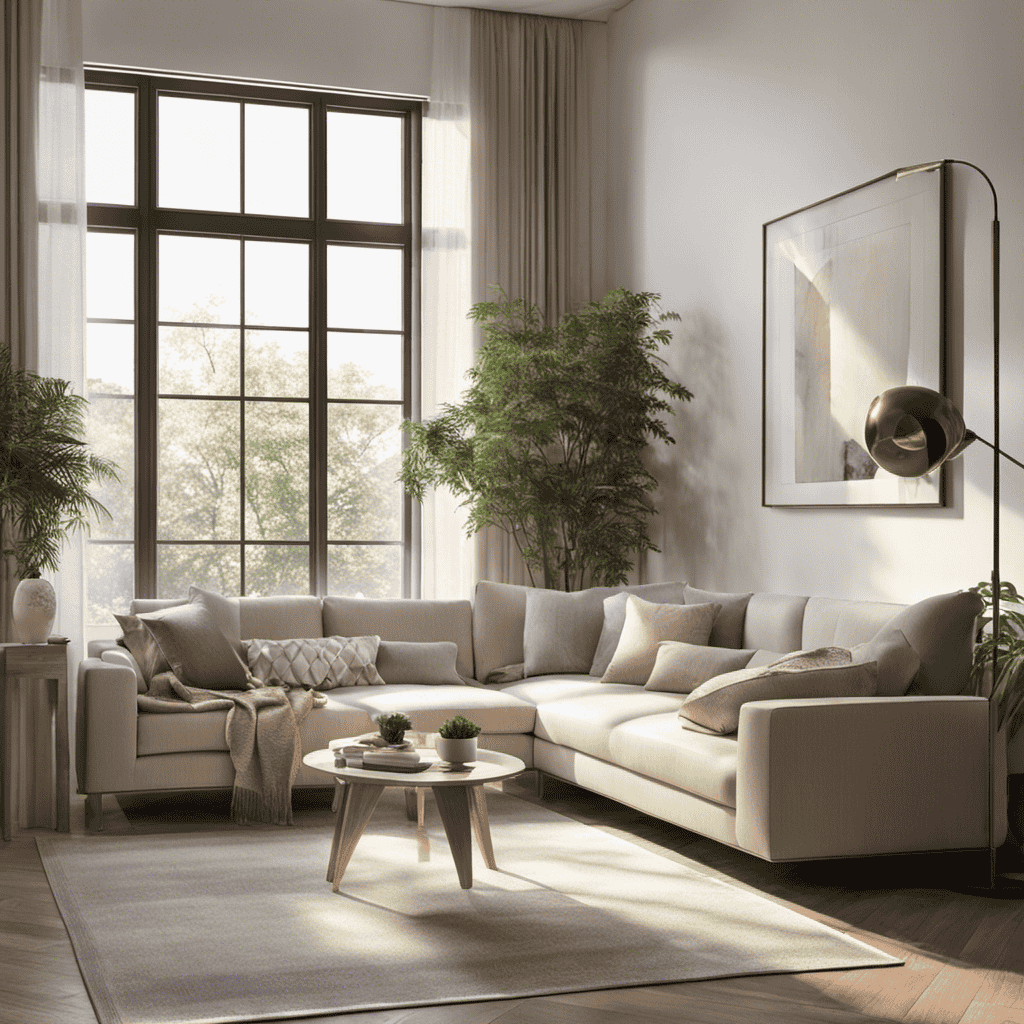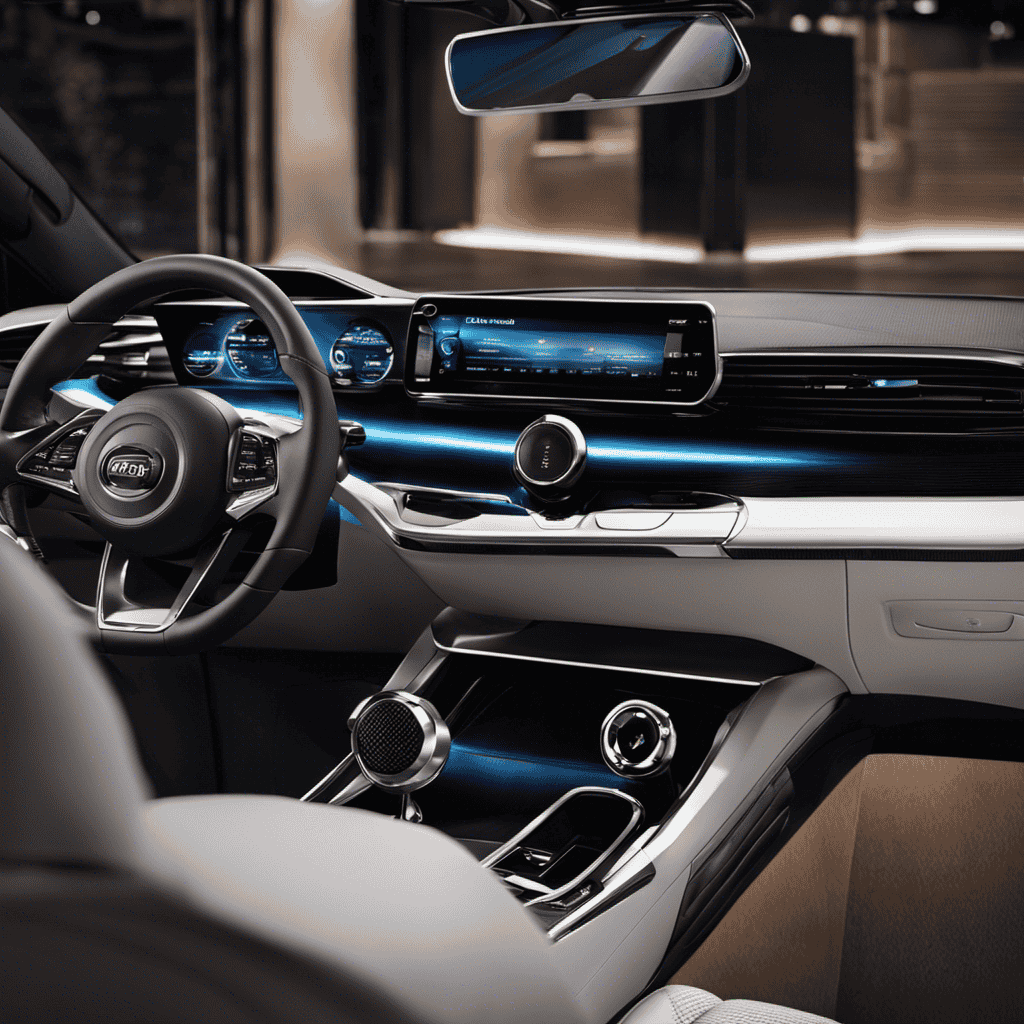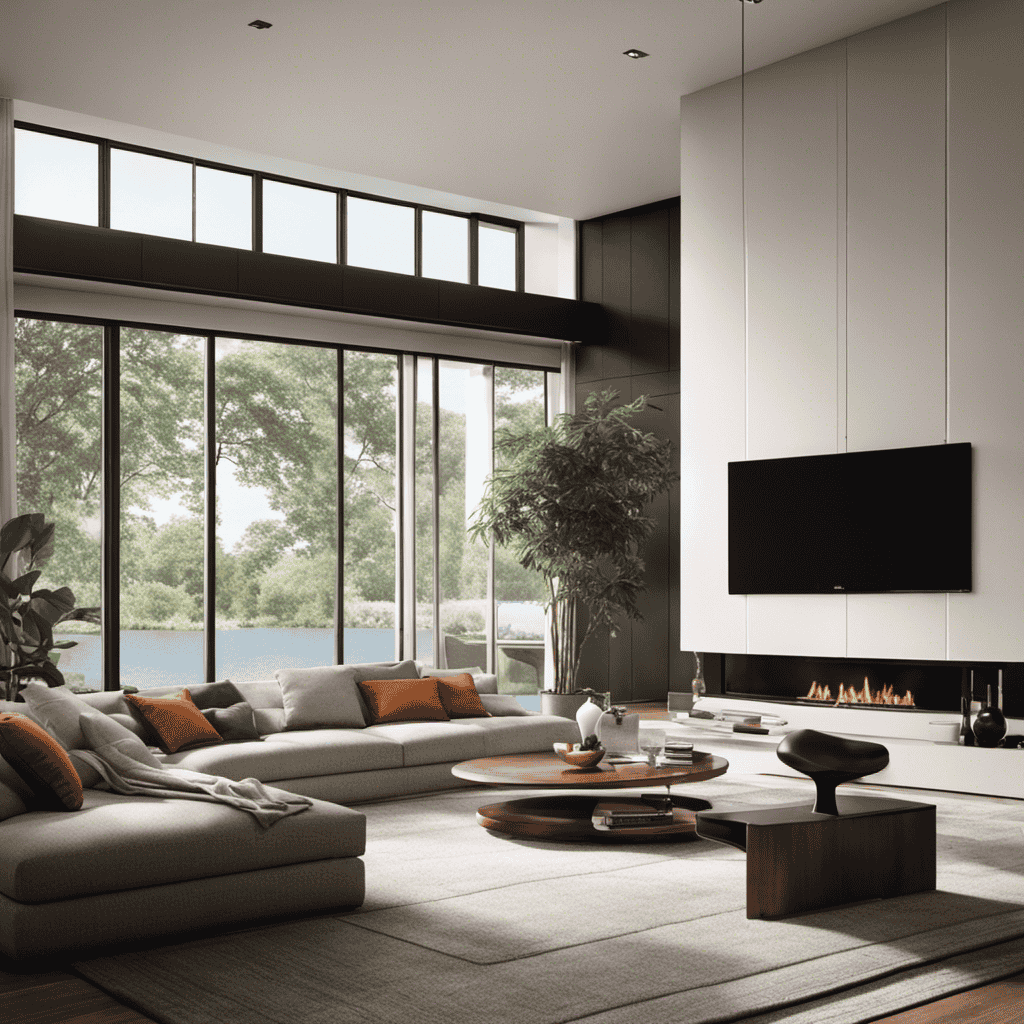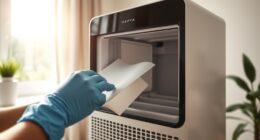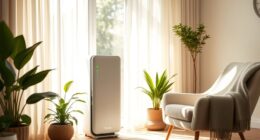As someone who is passionate about air purifiers, I have frequently wondered about the best operating time for these effective devices. How long should we allow them to run, continuously purifying our indoor air?
Well, fear not, because in this article, we will delve into the depths of air purifier usage and explore the factors that affect their runtime. From room size to allergies, we’ll leave no stone unturned.
So, sit back, relax, and let’s uncover the secrets of how long to run an air purifier for optimal results.
Key Takeaways
- Room size, air quality level, room ventilation, placement of the purifier, and type of pollutants are factors that affect the runtime of an air purifier.
- The recommended runtime for small rooms is 2-4 hours, for medium rooms is 4-6 hours, and for large rooms is 6-8 hours.
- Filters should be cleaned and replaced every 6 to 12 months for optimal performance.
- It is recommended to run the air purifier continuously for at least 8 hours a day, adjusting the schedule based on various factors such as room size, air quality, allergies or asthma, and time spent indoors.
Understanding Air Purifier Usage
To understand how long you should run an air purifier, it’s important to consider factors such as the size of your space and the air quality in your area. Adjusting air purifier settings can also impact the duration of usage.
The benefits of running an air purifier are numerous. Not only does it help remove airborne pollutants such as dust, pollen, and pet dander, but it also improves indoor air quality, reducing the risk of respiratory issues and allergies. Additionally, air purifiers can help eliminate unpleasant odors and harmful volatile organic compounds (VOCs) from the air.
The length of time you should run an air purifier depends on these factors and your specific needs. It is recommended to run the purifier continuously or for several hours a day to maintain clean and healthy indoor air. Regularly monitoring the air quality and adjusting the purifier settings accordingly will ensure optimal performance.
Factors Affecting Air Purifier Runtime
When considering the runtime of an air purifier, there are several key factors that come into play.
First, the size of the room can have a significant impact on how long the air purifier needs to run. A larger room may require a longer runtime to effectively clean the air.
Additionally, the air quality level in the room is another important consideration. If the air is heavily polluted, the air purifier may need to run for a longer duration to achieve the desired level of purification.
Room Size Impact
The size of the room affects how long you should run an air purifier. When it comes to adjusting the runtime for small spaces, it’s important to consider the square footage of the room. A larger room will require a longer runtime to effectively clean the air, while a smaller room may only need a shorter runtime. Additionally, the placement of the air purifier within the room can also impact its effectiveness. Placing the unit in a central location can ensure optimal air circulation and coverage. To help you better understand how room size and placement can affect air purifier runtime, refer to the table below:
| Room Size (in square feet) | Recommended Runtime |
|---|---|
| Small (under 100 sq ft) | 2-4 hours |
| Medium (100-250 sq ft) | 4-6 hours |
| Large (250+ sq ft) | 6-8 hours |
Air Quality Level
Air quality levels can greatly impact the effectiveness of an air purifier. When the air quality in a room is poor, with high levels of air pollutants, the air purifier needs to work harder to clean the air. This means that it may take longer for the air purifier to achieve clean and healthy air in the room.
Additionally, the effectiveness of the air purifier can also be affected by the room’s ventilation. If the room is poorly ventilated, it can hinder the air purifier’s ability to circulate the air and remove pollutants effectively.
Therefore, it is important to consider the air quality level and the room’s ventilation when determining how long to run an air purifier. By taking these factors into account, you can ensure that your air purifier is running efficiently and providing you with clean and fresh air.
Filter Lifespan Duration
To maximize the lifespan of your filter, it’s important to regularly clean and maintain it. A well-maintained filter can significantly improve the efficiency and performance of your air purifier.
The frequency of filter replacement depends on various factors, such as the type of filter, the air quality in your home, and the manufacturer’s recommendations. Generally, it is recommended to replace your air purifier filter every 6 to 12 months. However, it’s important to check the maintenance schedule provided by the manufacturer to ensure you are following their specific guidelines.
Regularly cleaning and replacing your filter will ensure that your air purifier continues to effectively remove pollutants from the air, providing you with clean and fresh indoor air.
Now, let’s move on to discussing the recommended run time for air purifiers.
Recommended Run Time for Air Purifiers
You should consider the recommended run time for your air purifier. Factors to consider when adjusting run time include the size of your room, the level of air pollution, and the efficiency of your air purifier.
Larger rooms or rooms with higher levels of pollution may require longer run times to effectively clean the air. On the other hand, if you have a smaller room or the air quality is relatively good, you may be able to adjust the run time accordingly.
It is important to note that running an air purifier for too long or too short can affect its performance and energy consumption. Therefore, it is recommended to consult the manufacturer’s guidelines or seek professional advice on the appropriate run time for your specific air purifier model.
Adjusting Air Purifier Runtime Based on Room Size
Consider adjusting the runtime of your air purifier based on the size of the room. This is an important factor to optimize the purifier’s effectiveness and performance. Here are four key points to keep in mind when adjusting the settings:
-
Room Size: Larger rooms generally require longer runtime to ensure thorough air purification. Smaller rooms, on the other hand, may only need shorter runtime for effective purification.
-
Air Quality: If the air in your room is heavily polluted or contains strong odors, you may need to increase the runtime to ensure the purifier has enough time to effectively remove contaminants.
-
Occupancy: If the room is frequently occupied or if there are pets present, adjusting the runtime can help maintain consistently clean air and minimize allergens.
-
Purifier Capacity: Consider the maximum coverage area and recommended runtime provided by the manufacturer. Adhering to these guidelines will help optimize the purifier’s performance and ensure efficient air purification.
Determining Air Purifier Runtime for Allergies
When it comes to purifying the air in my home, I want to make sure I’m doing it effectively and efficiently. That’s why I’m interested in understanding the optimal daily purifying time for my air purifier.
Additionally, I know that adjusting the runtime of the purifier based on the size of the room is crucial for maximum effectiveness.
Optimal Daily Purifying Time
To optimize the daily purifying time for your air purifier, it’s important to determine the ideal duration based on your specific needs and the air quality of your space.
Here are four factors to consider when adjusting purifier settings and determining the purifier runtime for pollution control:
-
Room size: Larger rooms may require a longer runtime to ensure efficient air purification throughout the space.
-
Air quality: If your space has higher levels of pollution or allergens, you may need to run the purifier for a longer duration to effectively remove these contaminants.
-
Sensitivity to pollutants: Individuals who are more sensitive to pollutants may benefit from running the purifier for an extended period of time to maintain clean and healthy air.
-
Time spent indoors: If you spend a significant amount of time indoors, especially in a polluted environment, running the purifier for longer periods can help maintain better air quality throughout the day.
Adjusting Runtime for Effectiveness
To maximize the effectiveness of your air purifier, it’s crucial to adjust the runtime based on factors such as room size, air quality, sensitivity to pollutants, and time spent indoors. Finding the right purifier settings can greatly improve the air quality in your home and help you breathe easier. Adjusting the runtime for efficiency means ensuring that your air purifier runs for the appropriate amount of time to effectively clean the air in your space. Consider the following table as a guide to help you determine the optimal runtime for your air purifier:
| Room Size | Air Quality | Sensitivity to Pollutants | Time Spent Indoors | Recommended Runtime |
|---|---|---|---|---|
| Small | Good | Low | Limited | 2-4 hours |
| Medium | Average | Moderate | Moderate | 4-6 hours |
| Large | Poor | High | Extended | 6-8 hours |
Considering Room Size
Considering the size of your room, it’s important to choose an appropriate air purifier that can effectively clean the air in that specific space. Here are four key factors to consider when selecting an air purifier for your room:
-
Room Size: Determine the square footage of your room to find an air purifier that is designed to handle that specific size. Using an air purifier that is too small for your room will result in inadequate air cleaning.
-
CADR Rating: Look for an air purifier with a high Clean Air Delivery Rate (CADR) rating. This rating indicates the purifier’s efficiency in removing pollutants like dust, pollen, and smoke from the air. The higher the CADR rating, the faster and more effectively the air purifier can clean the room.
-
Filtration System: Consider the type of filtration system used in the air purifier. HEPA filters are highly efficient in capturing small particles, while activated carbon filters are effective in removing odors and chemicals.
-
Noise Level: Check the noise level of the air purifier, especially if you plan to use it in a bedroom or workspace. Look for models with a low noise level to ensure a peaceful environment.
Air Purifier Runtime for Asthma Relief
Using an air purifier can help reduce asthma symptoms.
When it comes to air purifier runtime for respiratory health, it is essential to consider the specific needs of individuals, especially children.
The optimal runtime of an air purifier depends on various factors, such as the severity of asthma symptoms, the size of the room, and the air quality in the surrounding environment.
For children with asthma, it is recommended to run the air purifier continuously throughout the day and night. This ensures that the air is constantly filtered and allergens, pollutants, and irritants are effectively removed.
However, it is crucial to consult with a healthcare professional to determine the appropriate air purifier runtime for your child’s specific condition and needs.
Air Purifier Runtime for Pet Odor Control
When it comes to controlling pet odors with an air purifier, there are several key points to consider.
First, understanding the optimal runtime for the purifier is essential for maximum effectiveness.
Second, implementing the right strategies for pet odor elimination can make a significant difference in the air quality of your home.
And finally, knowing the duration it takes to see noticeable results is crucial for evaluating the effectiveness of your chosen methods.
In this discussion, I will delve into these topics and provide data-driven insights to help you effectively tackle pet odors in your home.
Optimal Purifier Runtimes
To get the most out of your air purifier, you should aim for optimal runtimes. Adjusting purifier settings and considering the purifier runtime for pollution control are crucial factors in maximizing the effectiveness of your air purifier. Here are four key points to keep in mind:
-
Understand your air quality: Monitor the pollution levels in your area and adjust the settings accordingly. Higher pollution levels may require longer runtimes to achieve optimal air quality.
-
Consider room size: Larger rooms may require longer runtimes to ensure thorough air purification. Take into account the square footage of the room and the purifier’s recommended coverage area.
-
Balance energy consumption: While longer runtimes may be beneficial, consider energy consumption. Find the balance between achieving clean air and conserving energy by running the purifier during peak pollution times or in specific areas of the house.
-
Regular maintenance: Clean or replace filters as recommended by the manufacturer. This will help maintain the purifier’s efficiency and ensure optimal performance.
Pet Odor Elimination Strategies
When it comes to pet odor control, there are several techniques that can help eliminate unwanted smells from your home. One effective method is to use an air purifier specifically designed for pet odors. These purifiers are equipped with filters that can capture pet dander, hair, and other particles that contribute to odor. But how do you select the right air purifier for your needs? Consider factors such as the size of your space, the type of pets you have, and the specific features of the purifier, such as activated carbon or ozone generators. To help you make an informed decision, here is a table outlining some popular air purifiers for pet odor control:
| Air Purifier Model | Coverage Area (sq. ft.) | Special Features |
|---|---|---|
| Brand A | 500 | Activated Carbon |
| Brand B | 800 | HEPA Filter |
| Brand C | 1000 | Ozone Generator |
Duration for Noticeable Results?
By using the right specifications, you can effectively tackle pet odors in your home and see noticeable results.
When it comes to running an air purifier to eliminate pet odors, the recommended run time can vary depending on the size of your space and the severity of the odors. However, here are four general guidelines to consider when adjusting the runtime of your air purifier:
-
Start with a minimum of 4-6 hours per day: This will allow the air purifier enough time to filter the air and capture pet odors effectively.
-
Increase runtime during peak odor times: If you notice that the pet odors are more prominent at certain times of the day, consider running the air purifier for longer during those periods.
-
Adjust based on odor intensity: If the pet odors are particularly strong, you may need to increase the runtime to ensure optimal results.
-
Monitor the air quality: Use an air quality monitor to track the effectiveness of your air purifier. If the odor levels are still high, you may need to extend the runtime accordingly.
Air Purifier Runtime for Smoke Elimination
If you want to eliminate smoke, you should run the air purifier for at least a few hours. When it comes to cigarette smoke, the runtime of the air purifier becomes even more crucial.
Cigarette smoke contains numerous harmful chemicals and toxins that can linger in the air for an extended period. Running the air purifier for a few hours will help to remove these contaminants effectively.
However, it’s important to consider the placement of the air purifier as well. Placing the air purifier near the source of smoke, like an ashtray or smoking area, can significantly improve its performance. This ensures that the smoke is captured and filtered right at the source, preventing it from spreading throughout the room.
Energy-Efficient Air Purifier Usage
When it comes to using air purifiers efficiently, it is important to consider both the optimal usage duration and power-saving techniques.
By understanding how long to run an air purifier and implementing energy-saving strategies, we can maximize its effectiveness while minimizing electricity consumption.
In this discussion, we will delve into the data-driven insights and practical tips that will help us make informed decisions about using air purifiers in an energy-efficient manner.
Optimal Usage Duration
To maximize the effectiveness of your air purifier, it’s recommended that you run it continuously for at least 8 hours a day. This optimal runtime ensures that the air in your space is constantly filtered, removing pollutants and allergens.
However, it’s important to adjust the schedule based on your specific needs and the air quality of your environment. Here are four factors to consider when determining the optimal runtime for your air purifier:
- Room Size: Larger rooms may require longer runtime to ensure thorough purification.
- Air Quality: If you live in an area with high pollution or have pets, longer runtime may be necessary.
- Allergies or Asthma: Individuals with allergies or asthma may benefit from longer runtime to maintain clean air.
- Time Spent Indoors: If you spend more time indoors, running the air purifier for longer periods can help maintain better air quality throughout the day.
Power-Saving Techniques
To conserve energy and lower your electricity bill, you can try using power-saving techniques with your air purifier. By adjusting the runtime of your air purifier, you can effectively reduce energy consumption without compromising its performance. Here are some power-saving techniques you can implement:
| Technique | Description | Benefits |
|---|---|---|
| Use a timer | Set a timer to run your air purifier for a specific duration, targeting the times when you need it the most. | Reduces unnecessary runtime and saves energy. |
| Adjust fan speed | Lower the fan speed of your air purifier to reduce power consumption while maintaining adequate air filtration. | Decreases energy usage without sacrificing air quality. |
| Utilize sensors | Some air purifiers have sensors that detect air quality levels. Set your purifier to automatically adjust its runtime based on the air quality in the room. | Optimizes energy usage by running only when necessary. |
Nighttime Air Purifier Runtime
The recommended nighttime air purifier runtime is usually around 8-10 hours. During this time, the air purifier works diligently to remove pollutants, allergens, and other harmful particles from the air in your home. Optimizing nighttime air purifier usage can have numerous benefits, including improved indoor air quality, reduced allergies and respiratory issues, and better sleep.
Here are four key ways to make the most of your nighttime air purifier:
- Place the air purifier near your bed to maximize its effectiveness while you sleep.
- Set the purifier to a lower fan speed or noise level to ensure a peaceful night’s sleep.
- Use a timer feature to automatically turn the purifier off after the recommended runtime.
- Regularly clean and maintain your air purifier to ensure optimal performance.
By following these guidelines, you can optimize the benefits of your nighttime air purifier usage.
Moving on to daily air purifier runtime recommendations…
Daily Air Purifier Runtime Recommendations
For optimal results, you should consider adjusting the daily runtime of your air purifier based on the specific needs of your home and the air quality in your area. By doing so, you can effectively reduce noise and control dust levels in your living space. To determine the ideal runtime, you can refer to the following table:
| Air Quality Level | Recommended Runtime |
|---|---|
| Excellent | 4-6 hours |
| Good | 6-8 hours |
| Fair | 8-10 hours |
| Poor | 10-12 hours |
| Very Poor | 12-16 hours |
Weekly Air Purifier Runtime Maintenance
You should regularly check and clean the filters of your air purifier to ensure that it continues to operate efficiently and effectively. Here are some weekly maintenance and troubleshooting tips to keep your air purifier running smoothly:
-
Clean or replace the filters: Over time, dust and particles can accumulate on the filters, reducing their effectiveness. It’s recommended to clean or replace the filters weekly to maintain optimal performance.
-
Check the fan and vents: Make sure the fan is running smoothly and the vents are clear of any obstructions. Blocked vents can reduce airflow and hinder the air purification process.
-
Monitor the air quality sensor: Some air purifiers have built-in sensors that detect the air quality. Keep an eye on the sensor readings and take appropriate action if the air quality is not improving.
-
Reset the timer and indicators: If your air purifier has a timer or indicator lights, reset them regularly to ensure accurate monitoring and efficient operation.
Extended Air Purifier Usage for Optimal Results
In my previous subtopic, I discussed the importance of weekly air purifier runtime maintenance. Now, let’s dive into extended air purifier usage for optimal results. To maximize air purifier effectiveness and purifier runtime efficiency, it’s crucial to understand how long to run an air purifier.
To help you determine the ideal runtime for your air purifier, I have created a table showcasing the recommended runtime based on room size:
| Room Size | Recommended Runtime |
|---|---|
| Small (up to 300 sq. ft) | 4-6 hours per day |
| Medium (300-600 sq. ft) | 8-10 hours per day |
| Large (600+ sq. ft) | 12-16 hours per day |
Air Purifier Runtime for Seasonal Allergies
To effectively manage your seasonal allergies, it’s important to adjust the runtime of your purifier based on the severity of symptoms. Here are 4 considerations for determining the recommended purifier runtime and adjusting it for allergies:
-
Monitor your symptoms: Keep track of how your allergies are affecting you throughout the day. If your symptoms are worse in the morning or evening, consider running the purifier during those times.
-
Check the pollen count: Stay informed about the pollen levels in your area. On high pollen days, it may be beneficial to run your purifier for longer periods to filter out the allergens.
-
Consider your indoor air quality: If you have pets or live in an area with high pollution levels, you may need to run your purifier for more extended periods to maintain clean air indoors.
-
Experiment and observe: Everyone’s allergies are unique, so it’s essential to experiment with different runtime settings and observe how your symptoms respond. Adjust the runtime accordingly to find the optimal balance for your allergies.
Factors to Consider When Determining Air Purifier Runtime
Adjusting the purifier’s runtime can be influenced by factors such as pollen count, indoor air quality, and individual allergy symptoms.
Understanding purifier technology is crucial in determining the appropriate runtime. Different air purifiers have varying capacities to filter out pollutants, and knowing the specific capabilities of your purifier can help optimize its usage.
Additionally, monitoring the pollen count in your area can guide you in adjusting the runtime accordingly. If the count is high, it is advisable to run the purifier for a longer period to ensure efficient removal of allergens.
Furthermore, considering the indoor air quality is essential. If you live in an area with poor air quality or if the indoor space is prone to pollutants, it may be necessary to run the purifier for extended periods.
Lastly, individual allergy symptoms should also be taken into account. If you experience severe allergies, running the purifier for longer durations can provide relief. However, it is important to strike a balance as excessive use of the purifier can lead to increased noise levels, causing disturbance during sleep or daily activities. Therefore, determining noise levels is also crucial in adjusting the purifier’s runtime.
Frequently Asked Questions
Can Air Purifiers Be Used 24/7?
Yes, air purifiers can be used 24/7. However, it’s important to consider the cost of running an air purifier continuously. The benefits of using an air purifier include improved air quality and reduced allergens.
How Often Should I Change the Filters in My Air Purifier?
I change the filters in my air purifier every 3-6 months. Regular maintenance is important to ensure clean air. Signs of a dirty filter include reduced airflow, increased dust in the room, and strange odors.
Can Air Purifiers Remove Viruses and Bacteria From the Air?
Air purifiers can effectively remove viruses and bacteria from the air, providing numerous benefits for households. Their ability to target common allergens makes them a valuable tool in maintaining clean and healthy indoor air.
Is It Safe to Run an Air Purifier While Sleeping?
I love running my air purifier while I sleep because it helps me breathe easier and wake up feeling refreshed. Contrary to common misconceptions, it is safe and beneficial to use an air purifier during sleep.
How Much Electricity Does an Air Purifier Consume?
Considering the energy efficiency of air purifiers is crucial for cost analysis. It’s necessary to understand how much electricity they consume. By evaluating their power usage, we can determine the optimal duration to run them.
Conclusion
In conclusion, determining the appropriate runtime for your air purifier is crucial in maintaining optimal indoor air quality.
According to a recent study by the Environmental Protection Agency (EPA), it is recommended to run an air purifier for at least 6 to 8 hours a day to effectively remove airborne pollutants.
However, this duration may vary depending on factors such as room size, allergies, and specific needs.
By understanding these factors and adjusting the runtime accordingly, you can ensure that you and your loved ones breathe in clean and healthy air.
